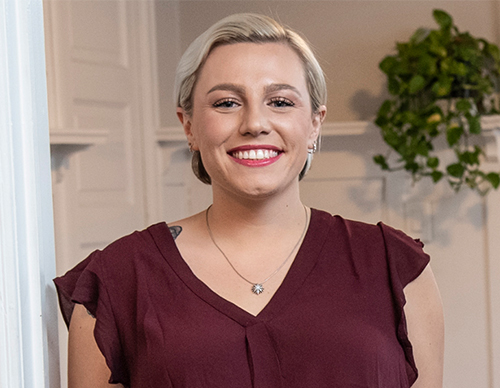It was as great an experience as it could be. Everyone treated me with respect, and they were so comforting and attentive.
Seeing Clearly Now
Caroline was a new teacher pursuing a master's degree in special education when her life was turned upside down in August 2015. She assumed the intense headaches she began experiencing were migraines. But when they were accompanied by a whooshing sound in her ears and vision problems such as blind spots, she knew it could be something worse. She left a visit to her doctor with a prescription for antibiotics, but the symptoms only intensified. It made it difficult to concentrate on her job and attend graduate school.
By that November, they were so bad she went to a local emergency room near her home in Port Washington, on Long Island. A spinal tap showed increased pressure in her head due to too much cerebrospinal fluid (CSF), which circulates through the brain and spinal cord. The body continuously creates and absorbs CSF. When CSF is produced faster than it is absorbed, it creates pressure within the skull, causing a condition known as idiopathic intracranial hypertension (IIH). The disorder is also called pseudotumor cerebri because its symptoms can mimic those of a brain tumor.
Caroline learned she had IIH. Normal CSF pressure is 15 to 20, but hers was 70. In addition to feeling terrible from the headaches, she was at risk of vision loss as her optic nerves continued to swell. Treatment with acetazolamide and other diuretics was ineffective. Three additional spinal taps provided temporary relief for a few days at a time, but they did not offer a long-term solution. Her doctors had no other recourse.
That's when Caroline took matters into her own hands, researching IIH online. Through her exhaustive search, she located Dr. Athos Patsalides, an interventional neuroradiologist, and Dr. Marc Dinkin, a neuro-ophthalmologist, both at NewYork-Presbyterian/Weill Cornell Medical Center's Brain and Spine Center. Together the doctors helped pioneer a procedure for IIH called "venous sinus stenting," which might offer Caroline the relief she so desperately needed.
Although the cause of increased pressure in the brain is often elusive, recent research has identified venous sinus stenosis as a potential cause of IIH. Venous sinus stenosis is a narrowing of a vein in the brain which can impair the absorption of CSF, resulting in increased pressure in the brain. The doctors saw Caroline within a week of her phone call in January 2016, identified her as a candidate for venous sinus stenting, and scheduled her for the procedure.
Since venous sinus stenting was investigational, she would undergo the procedure through a clinical trial. "I was a little nervous about that, but the treatment gave me hope," Caroline notes. "Dr. Patsalides and his team were so supportive. They were very calming and gave me the information I needed so I knew what was going to happen."
Traditional surgical treatments for IIH include the placement of a shunt in the brain to drain excess CSF and relieve pressure, or surgery around the optic nerve to relieve pressure around the optic nerve and protect vision. Stenting is less invasive than these operations and offered a chance for a better recovery, and Caroline liked those odds.
Accompanied by her parents, she arrived at the hospital a week later for the stenting. She was partially awake for the early part of the procedure — an angiogram where doctors located the narrowing in her brain and determined where the stent would go. Then she was fully sedated as they deployed the stent, snaking it up through a catheter inserted in her groin and threaded all the way up to her brain. The stent, a tiny mesh tube, was inserted into the narrowed area of the problem vein, opening up the canal through which CSF could now flow freely.
When Caroline woke up, the whooshing sound was gone, and so was her headache. "I felt like the pressure was taken off of my head," she recalls. She stayed in the hospital just one night, going home the next day and returning to work and school only a week later. Her vision took a little longer to recover, but was back to normal in about a month as the optic nerve swelling got better. She finished her degree and is now a special education teacher on Long Island.
Caroline sees her doctors every six months for a magnetic resonance venogram — a special scan to see the blood vessels in her brain — and to have her optic nerve and vision assessed. She's back to her usual level of activity: working out at the gym, playing lacrosse, and taking long walks with her dog, Harley, a Boston terrier mix.
She feels incredibly fortunate to have found Drs. Patsalides and Dinkin at NewYork-Presbyterian/Weill Cornell. "It was as great an experience as it could be. Everyone treated me with respect, and they were so comforting and attentive," Caroline concludes. "I'm so thankful for the team and for the hospital."



